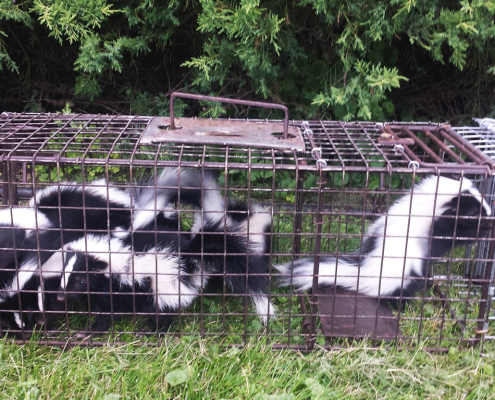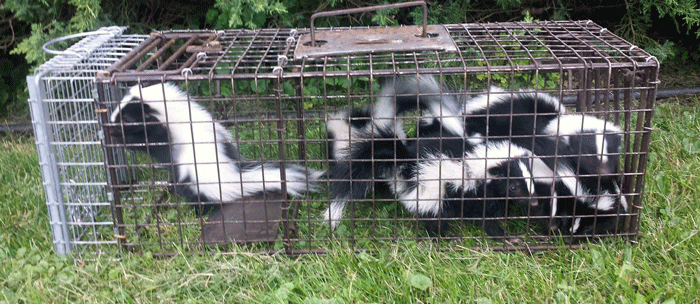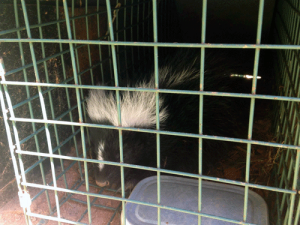
Skunks are widely known in our culture for the stinky surprise they leave for their attackers, however, it seems that a lot of people don’t know much more about them. Skunks in fact come in variety of shapes and sizes, and even though we tend to portray them with a black and white coat, they also have different colors. This article will tell you all about skunks and help you identify them.
Skunks are furry wild animals that can come in different colors and sizes, however, the most popular one is a black and white striped skunk. The colors and patterns may vary on their fur, but it always is a warning coloration. They are crepuscular and usually live in solitude, spending their days in underground dens. Skunks eat both animals and plants, and we can recognize them mainly by scratching and tearing sounds. Skunks use their scent glands to produce unpleasant smells to ward off potential attackers.
Skunks Solutions
Skunks Description
Skunks are mammals that can be found in North and South America. They are closely related to the stink badgers and those two species together create the family Mephitidae, which is recognizable for their tactics of deterring predators with smelly liquid from their scent glands. The skunk family is composed of 11 primarily nocturnal species that live in a variety of habitats – from forests and mountains, to even desert areas.
Even though the skunk in most people’s eyes are furry animals with black and white stripes, they actually have different colors – we can come across skunks with brown, grey, cream or reddish colors. Some of them are striped, while others wear no pattern or have spots or swirls on their fur. Various species of skunk differentiate in sizes, however, they can all be considered small to medium-sized wild animals, and very often their size can be compared to a house cat. Their build is adapted to constant digging – skunks have a rather stout build with elongated bodies and short, muscled legs. Skunks have long and sharp front claws that help them with digging burrows for shelter.
Most skunks are solitary in nature and active during twilight (the periods of dawn and dusk). This behavior changes when it comes to the mating season. In colder parts of North and South America, skunks gather together in communal burrows for warmth. During winter, skunks den for longer periods of time but are not considered hibernators, even though they remain quite inactive and only leave their dens occasionally to feed. Skunks sleep underground during the day and that’s why their long claws are so important – to dig a perfect shelter. A fact that not many know is that skunks have actually very short life spans – they only live around 3 years in the wild, while in captivity they can live up to eight years. It’s also important to understand that skunks have an excellent sense of smell and hearing, but unfortunately very poor vision which makes them vulnerable to road traffic.
Identifying skunk tracks is quite easy considering they have five toes on the front paws and four on the back, although a lot of people can still mistake skunks’ tracks for a common cats’ due to their similarities. It is crucial to remember that skunks cannot retract their claws, which means their tracks will leave large nail impressions. The front paw can also leave a track of the carpal pad, but that doesn’t happen too often due to the way skunks walk.
Analyzing wild animal waste may not be on your daily to-do list, however you may want to think about it when an animal shows up on your property and you wish to identify the intruder. Identifying the excrement that you find in your garden or around your property can be a perfect way of establishing which animal has decided to pay you a visit. Skunk droppings can look quite similar to those of raccoons and cats, so the best way of differentiating them is to pay more attention to its contents. Skunk’s feces often contain undigested berries, insects or even fur and feathers. These animals usually leave their droppings in gardens and lawns, but also close to their den. Their feces are most likely to be mushy, scattered and not well-formed.
Even though skunks are pretty quiet animals and are usually recognized by their smell, they do make a variety of noticeable sounds. If a skunk feels threatened, they will hiss, squeal, coo or growl and also stamp their feet, which is a popular tactic observed in pregnant females. Due to their long claws, we can also recognize skunks by scratching noises, tapping and tearing. These noises will most likely be heard during the night time, as skunks sleep during the day in their dens.
All skunk species are omnivores, which means they eat both meat and plants. They do change their diets during different seasons, but most skunks eat insects, rodents, small lizards, berries, leaves and roots. It is worth mentioning that the diet can differ slightly depending on the species and the area they live in. In urban areas, skunks that are used to humans are seeking our garbage and scavenging it for food. The reason why skunks often dig holes in our gardens is because they are looking for grubs and worms. A skunk will even try to eat your pets’ food, if it’s left in an accessible place.
The knowledge about skunks has risen in popularity mostly due to their specific tactics of defense – spraying extremely smelly liquid on their attacker. To do that, skunks use their anal scent glands which are much more developed than in any other species of the family Mustelidae. The spray can cause not only irritation to the predator’s eyes, but even cause temporary blindness. The smell that they leave can be powerful enough to even ward off a bear! It can be detected by a human nose up to almost 6km downwind.
 Skunks are furry wild animals known by their specific defense tactics of spraying their attacker with smelly spray. Even though they can be quite nice to have around as they feed on larvae of cutworms, hornworms and other insects that destroy our crops, they can also cause a little bit of trouble around your property. Read this article to see what damage skunks can do if they wander into your garden or lawn.
Skunks are furry wild animals known by their specific defense tactics of spraying their attacker with smelly spray. Even though they can be quite nice to have around as they feed on larvae of cutworms, hornworms and other insects that destroy our crops, they can also cause a little bit of trouble around your property. Read this article to see what damage skunks can do if they wander into your garden or lawn.
PROBLEMS CAUSED BY SKUNKS
Skunks are relatively harmless and do not pose a physical threat to us, but we still don’t welcome them in our garden with open arms. These mammals are certainly not aggressive, but their love of digging may be quite upsetting when we are trying to keep our garden nice and presentable. Skunks can also cause some problems for our domestic pets, which again makes them undesirable guests.
GARDEN DAMAGE
Skunks’ habits are unfortunately not in line with our idea of beautiful surroundings near our property. These mammals are known for burrowing and in their natural habitat they usually do it underneath trees, however when moved into more urban areas, skunks can burrow right under home foundations. These actions can lead to structural damage to our houses or other buildings. Apart from burrowing, skunks tend to chew through wood and siding to make a den. Trying to find the shelter is not the only problem skunks cause to our gardens though – they also dig in the lawn in search of food, as grubs and worms are part of their diet. As we can see, skunks can really be a pain if we are trying to keep our garden or yard looking nice.
STINKY SMELL
Skunk’s fluid sprayed on their potential attacker carries an obnoxious smell that doesn’t simply go away. If your pet encounters a skunk and unfortunately is treated with their defense tactics of smelly spray, then it may take days to get rid of it. The liquid contains sulfuric acid, which makes it cling to objects or living creatures. Eliminating the smell is extremely hard when a person or a pet has been treated with it. It is also important to know that skunks’ spray can cause nausea and vomiting, and when sprayed in the eyes, it may even lead to temporary blindness.
DISEASE
Like most wild animals, skunks can be carriers of various diseases. They may carry rabies and transmit it to both humans and other animals. The problem with skunks is that it’s hard to identify if they are infected, as we cannot observe them during the day. The best way of staying safe is to avoid contact with their saliva.
Skunks are not aggressive animals, but their cute furry look may be misleading, as they can cause some trouble near our property. We hope that this article helped you understand what a surprise skunk’s visit to your garden can mean to you and your family.
 Black and white skunks are popular in our culture due to the specific smell they leave when threatened. It is their defense tactic that we know about and immediately can think of when hearing the word skunk. However, there is much more to those animals than just their unique smelly spray. How much of a threat to us are they and are skunks in fact dangerous? Read on to find the answers.
Black and white skunks are popular in our culture due to the specific smell they leave when threatened. It is their defense tactic that we know about and immediately can think of when hearing the word skunk. However, there is much more to those animals than just their unique smelly spray. How much of a threat to us are they and are skunks in fact dangerous? Read on to find the answers.
ARE SKUNKS AGGRESSIVE?
Most skunks are not aggressive and will attack only when threatened. Before treating their attacker with smelly spray, a skunk will often charge and stamp their feet, or hiss to discourage the predator. If they still feel threatened, skunks will use their scent glands to spray the other animal or human with its smelly liquid that can cause irritation and even temporary blindness. There is only a small chance of a skunk attacking first, so if it’s left alone, a skunk does not pose any threat.
DO SKUNKS BITE?
It is very rare for a healthy wild skunk to bite a human, but it can happen with a tame skunk as they usually get their scent glands removed and biting becomes their new way of defense. They can bite other animals but it is not much of a defense against bigger predators, so it happens rarely – skunks will use their foul-smelling spray to get rid of an attacker rather than their teeth.
SPREADING DISEASE
Unfortunately, skunks can be dangerous to us and our pets in a different way – by spreading diseases. They can carry rabies and infect you or your pet through a scratch or a bite – when it happens, you should seek medical attention immediately. Even though it is quite difficult to identify an infected skunk as they usually cannot be observed during the day, one of the signs of rabies might be wandering erratically during daylight hours. Another symptom of rabies in skunks is behaving aggressively and fearlessly around humans or pets.
SKUNKS’ DROPPINGS
Skunks’ feces can pose another threat to us as their excrement can be full of dangerous and harmful bacteria. It can transmit both to pets and humans, and it is crucial to understand that it poses a danger not only when it’s fresh. Skunks’ droppings can harbor parasites that are infectious for days, or even weeks after the animal has left their feces in our garden. When you want to dispose of skunks’ excrement, remember to follow special handling and disposal procedures.
Skunks as wild animals are not dangerous per se, as they won’t attack first and their defense mechanism is spraying a smelly liquid rather than biting. Unfortunately, these animals can carry diseases and parasites that can easily be spread to humans and pets. If we notice the presence of a skunk in our garden or around our property, we need to remember to be careful when handling it. he best idea is to call professionals and not deal with a skunk problem on your own.
